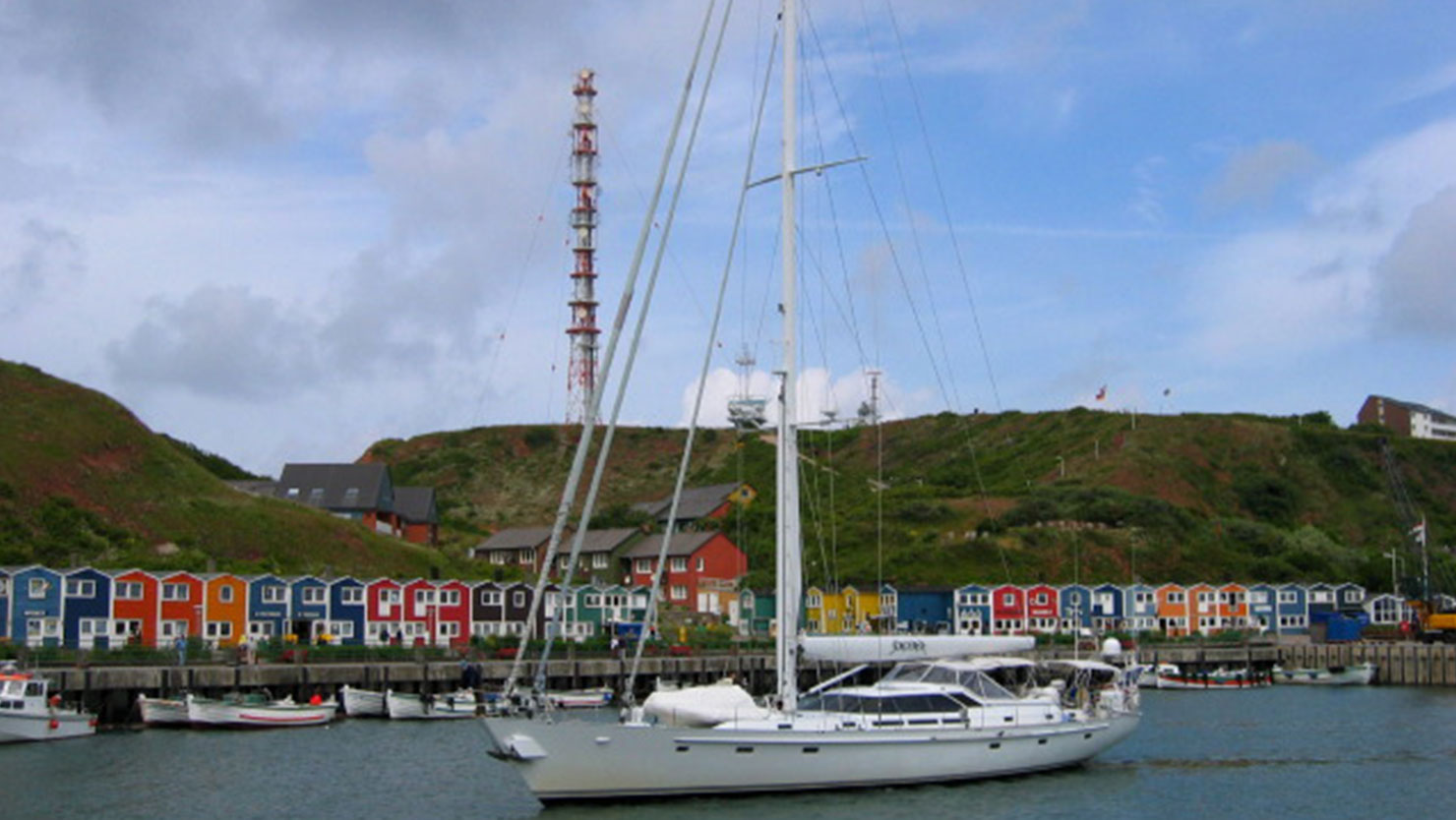Sampling in Helgoland — A warm German welcome for the Sorcerer II

After a little more than two weeks in Plymouth, UK the Sorcerer II set sail on June 3rd. We were sad to say goodbye to our new friends at PLM, but we were grateful for their hospitality, friendship and scientific collaboration. We're looking forward to coming back through Plymouth in the fall.
We motor sailed in calm weather but with all the other boat traffic in the English Channel we were on constant watch. On June 6th we arrived on Helgoland, an island about 70 kilometers from the mainland. While Germany has many islands on its coast this is the only high seas island and it is a beautiful land with red sandstone rock. Scientists from the Alfred-Wegener-Institute for Polar and Marine Research, the Biologische Anstalt Helgoland, the Jacobs University Bremen and the Max Planck Institute for Marine Biology joined the Sorcerer II crew to sample another long term research site called the Helgoland Roads Long Term Ecological Research Site or 'Kabeltonne.' The sampling site Kabeltonne is located just outside the main harbor of Helgoland located in the southeastern corner of the North Sea.
Dr. Frank Oliver Glöckner, Head of the Microbial Genomics Group at Max Planck Institute for Marine Microbiology was quoted in a press release regarding the collaboration with the Sorcerer II crew, "Sequence data from the Sorcerer II will complement and improve our own MIMAS data. I asked Frank to contribute to our blog so what follows below is his and his team's account of their experience to have the Sorcerer II come to Helgoland.
Sunday afternoon the Sorcerer II crew toured the Alfred-Wegener-Institute for Polar and Marine Research facilities and aquarium. The tour was led by Dr. Karen Wiltshire, director of Biologische Anstalt Helgoland & Wadden Sea Station Sylt, and was followed by a tasty BBQ hosted by researchers Sonja Oberbeckmann and Katherina Schoo. It was a wonderful day and our hosts in Helgoland were superb. A heartfelt "thank you" from the entire Sorcerer II crew.
From our collaborators in Germany:
Helgoland Ahoy. The Sorcerer II has reached the first German harbor.
Already some weeks ago rumors came up that the Sorcerer II might have a sampling stopover in Helgoland, a rocky island in the middle of the North Sea. E-mails were flying back and forth to get the permits and organize the stay. June 2nd we got the message that the crew has left Plymouth and is now heading for Helgoland. We were excited - the Sorcerer II will really come to Helgoland and even stay two nights in the harbor! Those not living on Helgoland quickly organized their travel.
From the other side of the island you could see the large mast of the Sorcerer II. We could not wait to get in contact with the crew and what a warm welcome! Like a swarm of grasshoppers we entered the ship for a visit. All of us wanted to have a look how this beautiful yacht looks from inside. How do the sampling devices look like? How do you store and ship the filters? Many questions arose and got answered patiently by the crew. Action came up when we were allowed to join the sampling of the Helgoland Roads Long Term Ecological Research Site named 'Kabeltonne'. In former times a buoy was anchored at this site to hold a cable connecting the main island with the Dune, a sandy smaller island populated mainly by seals and tourists in the summer months. The 'Kabeltonne' itself has been removed many years ago and is now standing as a reminder of former times in front of the Biological Station Helgoland (BAH) as part of the Alfred-Wegener-Institute for Polar and Marine Research (AWI). Nevertheless, since nearly 50 years samples are taken at this station to monitor food web interactions and the influence of climate change and the diversity of microbial communities in the North Sea.
Sampling with the Sorcerer II at the station 'Kabeltonne' goes quickly, the real work with all the filtrations and finally sequencing and data analysis comes later explains Jeff, the lead scientist on board. The sequence data from the Sorcerer II will complement and improve our data of the recently started MIMAS (Microbial Interactions in MArine Systems) project. The MIMAS project generates and integrates diversity, metagenomic, metatranscriptomic and metaproteomic data with contextual data like temperature and nutrient concentrations. It's exciting - with the Sorcerer II data we are now able to compare the North Sea with marine habitats on a global scale. The day finishes with a barbecue at the BAH including traditional Helgoland food and some duty-free drinks. At the end it's like we say good bye to good friends. The Sorcerer II has to leave for the Baltic and finally to pick up J. Craig Venter in Stockholm. Nevertheless, we hope that we do not need magic to convince the crew to have another stopover on their way back in August when they finally go to the Mediterranean for the winter.
We all wish you a good trip and happy sampling:
Sonja Oberbeckmann, Uwe Nettelmann, Alexandra Kraberg, Katherina Schoo, Gunnar Gerdts, Karen Wiltshire (all AWI), Manfred Schlösser (Max Planck Institute for Marine Microbiology Bremen), Christine Klockow, Renzo Kottmann and Frank Oliver Glöckner (all MPI-Bremen and Jacobs University Bremen)